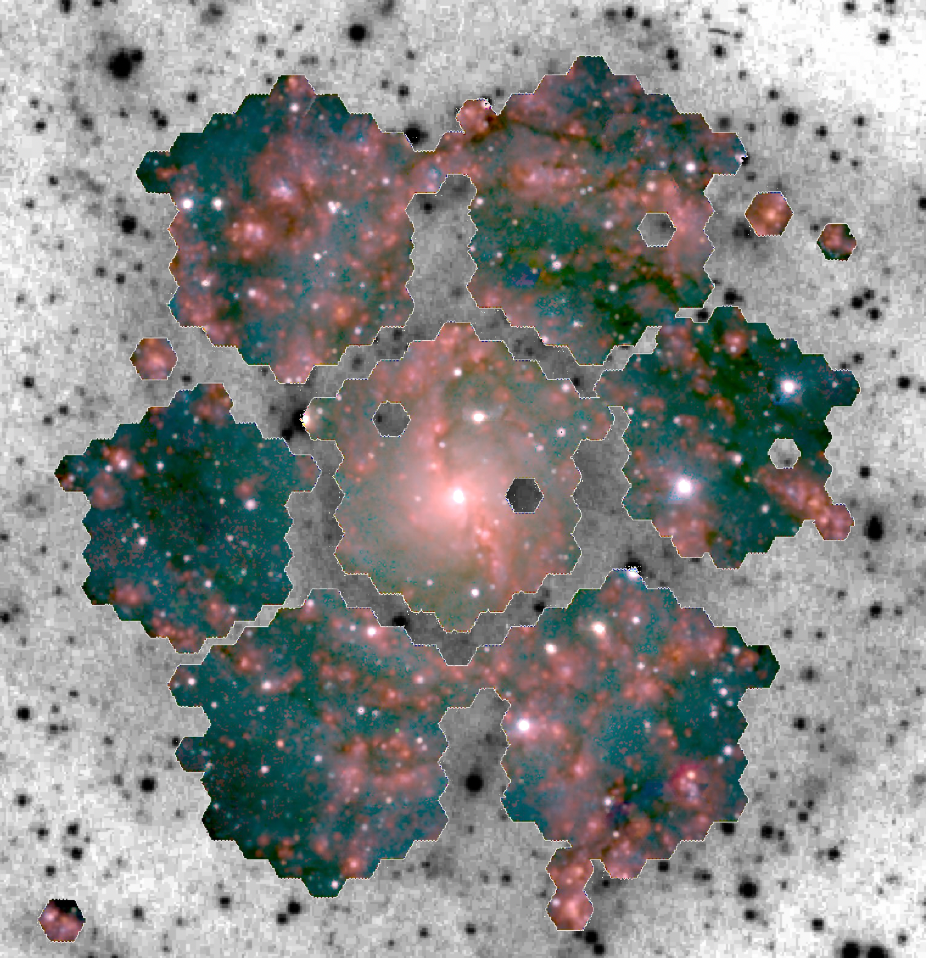IC342
Contact

| Kathryn Kreckel |
|---|
| Heidelberg University (ARI/ZAH) |
Summary
This program uniformly mosaiced 10×10 kpc in the disk of IC 342 at 32 pc scales to study the physics of star formation at cloud scales. The full mosaic uses 49 plates, including an initial pilot program of 3 plates that target individual HII regions across the disk.
Finding Targets
An object whose MANGA_TARGET3 or MNGTARG3 value includes one or more of the bitmasks in the following table was targeted for spectroscopy as part of this ancillary target program. See SDSS bitmasks to learn how to use these values to identify objects in this ancillary target program.
| Program (bit name) | Bit number | Target Description |
|---|---|---|
| IC342 | 20 | IC 342 targets |
Description
MaNGA has made huge advances on topics related to the physics of the ISM, but is fundamentally limited to ~kpc scale regions. By deriving average conditions weighted by luminosity, these results are biased towards the most massive star-forming sites. What is missing is a local reference that can inform our understanding of the unresolved physics. IC 342 (Hubble type SABcd) is the closest (3.3 Mpc; Saha et al. 2002) massive (log M* = 9.95; Zibetti et al. 2009) low-inclination (i=31 deg; Crosthwaite et al. 2000) star-forming (SFR = 1.87 MSun/yr; sSFR = 2.1×1010 per yr; Kennicutt et al. 2009) spiral galaxy. In IC342, the MaNGA fiber samples 2″ = 32 pc scales, resolving individual HII regions and making this one of the best targets in the whole sky to study the physics of star formation at cloud scales. It will also serve as a test case for the upcoming Local Volume Mapper as part of SDSS-V.
Only the largest IFUs (91 and 127 fibers) are on science targets, with the remaining IFUs targeting sky fields. The galaxy disk is just small enough that the individual IFU sky fibers can all successfully be placed on sky dominated regions outside the galaxy. This allows us to process all observations through the standard MaNGA pipeline without any additional adjustments/refinements. The data cubes in this ancillary program do not contain entire galaxies, but ~300 pc sub-regions within the disk, and therefore should be used with caution, and should not be used in standard analyses of the MaNGA sample. IC342 also suffers from high foreground Milky Way extinction (AV = 1.530; Schlafly & Finkbeiner 2011), which should be taken into account when performing any spectral fitting.
46 plates (10141-10150, 10480-10491, 12027-12050) were used to uniformly mosaic the central 10 arcmin diameter disk of IC 342. 3 pilot plates (9673, 9674, 9675) were initially observed to test the feasibility of this survey, with IFUs placed on HII regions that provide good radial and azimuthal coverage. Exposure times in the pilot observations were limited to 1h total (2 visits of 30m), but in the full survey consist of 1.5h total (2 visits of 45m).
References
Crosthwaite et al., 2000, AJ, 119, 1720
Kennicutt et al., 2008, ApJS, 178, 247
Saha et al., 2002, AJ, 124, 839
Schlafly & Finkbeiner, 2011, ApJ, 737, 103
Zibetti et al., 2009, MNRAS, 400, 1181


